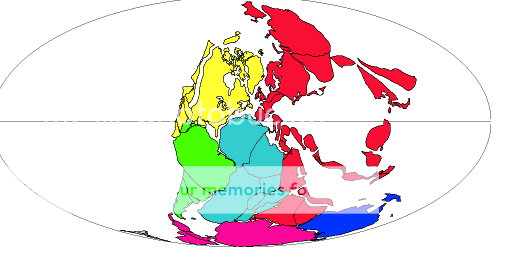Fossil burrows (trace fossils) in sandstone along the South Kaibab Trail in Grand Canyon National Park. Photo by foxult. March 2005.
How do fossils form?
“The term 'fossilisation' refers to a variety of often complex processes that enable the preservation of organic remains within the geological record. It frequently includes the following conditions: rapid and permanent burial/entombment - protecting the specimen from environmental or biological disturbance; oxygen deprivation - limiting the extent of decay and also biological activity/scavenging; continued sediment accumulation as opposed to an eroding surface - ensuring the organism remains buried in the long-term; and the absence of excessive heating or compression which might otherwise destroy it.
Fossil evidence is typically preserved within sediments deposited beneath water, partly because the conditions outlined above occur more frequently in these environments, and also because the majority of the Earth's surface is covered by water (70%+). Even fossils derived from land, including dinosaur bones and organisms preserved within amber (fossilised tree resin) were ultimately preserved in sediments deposited beneath water i.e. in wetlands, lakes, rivers, estuaries or swept out to sea.
Fossilisation can also occur on land, albeit to a far lesser extent, and includes (for example) specimens that have undergone mummification in the sterile atmosphere of a cave or desert. However in reality these examples are only a delay to decomposition rather than a lasting mode of fossilisation and specimens require permanent storage in a climate controlled environment in order to limit its affects.” [2]
So you’re standing on a sidewalk in uptown Charlotte...
In the tan, outside building blocks of the Levine Museum of the New South you will see some crazy, tube-like shapes.
The blocks are from the Lueders Limestone quarry in Leuders, TX, just north of Abilene. The rock is 270 million years old.
At that time, the land mass that is now North America straddled the equator, and much of central and western Texas was submerged in a shallow sea. A type of worm, Planolites, made networks of small furrows and possibly a shrimp, Thalassinoides, made larger scattered undulations. These are crawling traces of animals that fed in the sediment on the seafloor ages ago. Their burrows are preserved on the bottom layer of the deposit in relief because they were filled in with lime sediment after they were formed. [7]
Architect Malcolm Holzman, of Holzman Moss Architecture, recently used [Lueders] limestone to good effect in the new Student Union Building at Texas Tech University. “In the design process,” he said, “I visited the Lueders quarry and discovered a stone that was distinctive because of its irregularities. Its three-dimensional surface caught my attention.” [6]

The arrangement of today's continents 270 million years ago.

To receive credit for this Earthcache, you must do the following. Email me your answers. Do not post your answers in your log.
1) Measure the diameters of five different burrows and give the average of your measurements, which will give you an approximation of the thickness of the animals that made the burrows. Although using centimeters is preferable for the units, you may also use inches.
2) Burrows are just one type of trace fossil. Name any other type of trace fossil (not seen at this location).
3) What can you determine about the environment these animals lived in based on examining the rock outside the Levine Museum? Why do you say that?
4) (Optional) Take a photo of yourself with the worm burrows in the background. It would be nice if you smiled or looked excited to be there.
Parking/Lynx
Your best bet for parking is the Seventh St Parking deck, which is on 7th St, next to the Levine Museum of the New South. It costs money to park there and everywhere else in the area.
If you choose to visit the Museum of the New South (there’s an entry fee), “on weekdays, Levine Museum provides visitors 2 hours of validation for parking in Seventh Street Station parking deck, which is located next to the museum. After 2 hours, regular parking fees apply.
On weekends and for evening events, the museum provides parking validation, with no hourly limit.
Visitors should present parking ticket for validation at the Guest Services desk upon arrival.” [3]
You can park for free if you’re willing to park at one of the Lynx light-rail line stops and ride the Lynx into town. The closest Lynx stop to the cache is at 7th Street, which is only a block from the cache. There is a fee for riding the Lynx. See [4] for more info.
Sources
[1] “What are trace fossils” Nova Scotia Museum of Natural History. http://www.museevirtuel-virtualmuseum.ca/sgc-cms/expositions-exhibitions/fossiles-fossils/english/sections/whatare.html
[2] “What is a fossil? How do they form?” Discovering Fossils. http://www.discoveringfossils.co.uk/whatisafossil.htm
[3] Levine Museum of the New South. http://www.museumofthenewsouth.org/
[4] Lynx Stations and Parking. http://charmeck.org/city/charlotte/cats/lynx/ridinglynx/Pages/default.aspx
[5] Stories in Stone: Travels Through Urban Geology. (Review). http://geologywriter.com/books/stories-in-stone/
[6] Texas Quarries website. http://www.texasquarries.com/seatrace.htm
[7] Stone World website. “Limestone Creates a Focal Point at Texas Tech.” http://www.stoneworld.com/articles/limestone-creates-a-focal-point-at-texas-tech

USGS. http://geomaps.wr.usgs.gov/parks/pltec/scplseqai.html